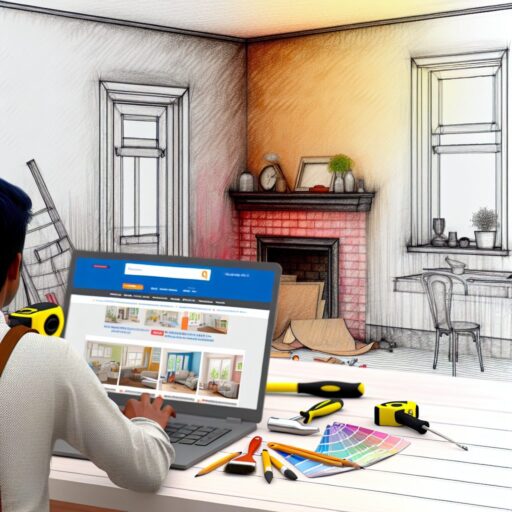Using The Web For Home Improvements
Is using the web for home improvements a good idea? The internet is a powerful tool. It can help us learn new things, shop for items, or find inspiration. Did you know it’s also great for home improvements? Whether you want to paint your walls, fix a sink, or build furniture, the web has what you need. With just a few clicks, you can find tips, videos, and tools to make your home better. This article will show you how to use the web to improve your home step by step. Let’s explore how the internet can turn any home project into a success!

Finding Ideas and Inspiration Online
![]()
Before starting any project, you need ideas. The internet is full of them! Websites like Pinterest and Instagram are great places to start. You can search for pictures of rooms, gardens, or projects that interest you. These platforms let you save photos to create your own mood board.
- Pinterest allows you to pin images to boards based on themes.
- Instagram lets you follow accounts that post home improvement ideas.
- YouTube offers video tours of homes and DIY tutorials.
For example, if you want to redecorate your bedroom, search for “bedroom makeover.” You’ll see thousands of ideas in seconds. Some websites even have virtual room designers. These tools let you see how colors, furniture, or decorations would look before you buy anything.
Many people share their real-life projects online. A family in Texas shared how they turned their backyard into a cozy outdoor space using only $300. Stories like these can inspire you to try something similar. Look for blogs or forums where people discuss their home improvement journeys.
Statistics show that 70% of homeowners use the internet to plan renovations. This proves how helpful these resources are. So, before picking up a hammer, spend some time browsing the web for ideas.
Learning Skills Through Online Tutorials
![]()
Not everyone knows how to fix things around the house. That’s okay! The web is full of tutorials to teach you. Platforms like YouTube, Skillshare, or Udemy offer lessons on almost any topic. From plumbing to painting, there’s something for everyone.
- YouTube is free and has millions of DIY videos.
- Skillshare offers courses taught by experts.
- Udemy provides detailed training at affordable prices.
Imagine your kitchen faucet is leaking. Instead of calling a plumber right away, search for a tutorial. Type “how to fix a leaky faucet” into YouTube. You’ll find step-by-step guides that walk you through the process. Many videos are made by professionals who explain things clearly.
Some websites also have written guides with pictures. For example, Home Depot’s website has a section called “How-To Projects.” It covers everything from building shelves to installing lights. Reading these guides can give you confidence to tackle small jobs yourself.
A survey found that 80% of people who watch DIY videos feel more capable of completing tasks. This shows how much we can learn online. Even if you’re a beginner, the web makes it easy to gain new skills.
Comparing and Buying Tools and Materials Online
![]()
Every home improvement project needs tools and materials. The internet makes shopping for these items simple. Websites like Amazon, Lowe’s, or Home Depot allow you to browse products without leaving your home.
- Amazon has reviews from customers to help you choose the best item.
- Lowe’s and Home Depot let you compare prices and features.
- Specialty stores often sell unique tools not found locally.
Let’s say you need paint for your living room. Search for “best wall paint” online. You’ll find lists of top-rated brands along with customer reviews. This helps you pick the right product for your needs. Some sites even offer virtual color testers. Upload a photo of your wall, and the site shows how different paints would look.
Shopping online also saves money. Many websites offer discounts or free shipping. If you’re unsure about a product, check its reviews. People often share photos and details about their experience. This feedback can prevent you from buying something that won’t work.
In 2022, 65% of homeowners said they purchased tools or materials online. It’s clear that the internet is a trusted source for shopping. Use it to find the best deals and highest-quality supplies for your project.
Hiring Professionals Through Online Platforms
![]()
Sometimes, a project is too big to handle alone. In those cases, hiring a professional is the best choice. The web makes finding skilled workers easier than ever. Websites like Thumbtack, Angie’s List, or TaskRabbit connect you with experts in your area.
- Thumbtack matches you with local professionals based on your needs.
- Angie’s List has reviews and ratings for contractors.
- TaskRabbit allows you to hire people for smaller tasks, like assembling furniture.
For example, imagine you want to remodel your bathroom. Search for “bathroom remodeling contractors” on Thumbtack. You’ll see a list of professionals nearby. Each profile includes their experience, pricing, and customer reviews. This helps you pick someone reliable.
Online platforms also let you compare quotes. You can contact multiple contractors and ask for estimates before making a decision. Some sites even have built-in messaging tools so you can communicate easily.
Studies show that 50% of people now use the internet to find contractors. This trend is growing because it saves time and ensures quality work. If your project feels overwhelming, don’t hesitate to seek help online.
Using Apps to Plan and Organize Projects
![]()
Staying organized is important for any home improvement project. Luckily, there are apps designed to help you plan every step. Apps like Trello, Houzz, and HomeZada make managing tasks easy and fun.
- Trello lets you create to-do lists and deadlines.
- Houzz offers design ideas and connects you with professionals.
- HomeZada tracks your budget and progress.
For instance, if you’re building a deck, use Trello to list all the steps. Create cards for tasks like buying wood, measuring the area, and assembling parts. Check off each task as you complete it. This keeps you on track and prevents forgetting anything important.
Apps like Houzz are also great for visualizing designs. You can upload photos of your space and try out different layouts or furniture pieces. Some apps even use augmented reality to show how items will look in real life.
Research shows that 40% of homeowners use apps to organize their projects. These tools make planning less stressful and more efficient. Give them a try for your next home improvement idea!
Joining Online Communities for Advice
![]()
Doing home improvements can sometimes feel lonely or confusing. But you’re not alone! Online communities bring people together to share advice and experiences. Forums like Reddit, Facebook Groups, or specialized DIY websites are great places to connect.
- Reddit’s r/HomeImprovement forum is full of helpful discussions.
- Facebook Groups let you join local or global DIY communities.
- DIY websites often have comment sections for asking questions.
Imagine you’re trying to install a ceiling fan but get stuck. Post your problem on a forum like Reddit. Within minutes, other users might reply with solutions. Some may even share links to videos or articles that explain the process.
Joining these groups also means learning from others’ mistakes. Someone might warn you about a product that didn’t work well for them. This can save you time and money. Plus, sharing your own successes can inspire others.
Surveys show that 60% of DIYers use online communities for support. These spaces are friendly and full of knowledge. Don’t hesitate to reach out when you need help or advice.
Avoiding Common Pitfalls with Online Resources
![]()
While the web is helpful, it’s important to use it wisely. Not all information online is accurate. Some websites may give poor advice or recommend low-quality products. Knowing how to avoid these pitfalls is key.
- Always check the source of the information.
- Read multiple reviews before buying a product.
- Be cautious of websites that seem too good to be true.
For example, if you read a guide about fixing a roof, make sure it’s from a trusted site. Experts like Bob Vila or This Old House are reliable sources. Avoid random blogs with no credentials.
Also, remember that cheaper isn’t always better. A $10 tool might break quickly, while a $30 one lasts for years. Look for balance between price and quality. Customer reviews often highlight these details.
By being careful, you can avoid wasting time or money. The web is a great resource, but it works best when used thoughtfully. Double-check everything before starting your project.
Conclusion: The Web For Home Improvements
![]()
The internet is an amazing tool for home improvements. It helps you find ideas, learn skills, shop for supplies, and hire professionals. Apps and communities keep you organized and supported. While there are challenges, being cautious ensures success.
Remember, every big project starts with a small step. Use the web to gather knowledge and confidence. Whether you’re painting a wall or building a deck, the internet can guide you every step of the way. With these tips, you’re ready to make your home better than ever!
